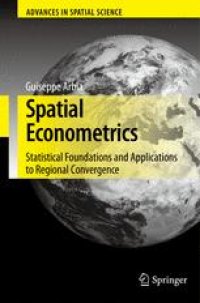
Ebook: Spatial Econometrics: Statistical Foundations and Applications to Regional Convergence
- Tags: Regional Science, Econometrics, Statistics for Business/Economics/Mathematical Finance/Insurance, Geographical Information Systems/Cartography
- Series: Advances in Spatial Science
- Year: 2006
- Publisher: Springer-Verlag Berlin Heidelberg
- Edition: 1
- Language: English
- pdf
In recent years the so-called new economic geography and the issue of regional economic convergence have increasingly drawn the interest of economists to the empirical analysis of regional and spatial data. However, even if the methodology for econometric treatment of spatial data is well developed, there does not exist a textbook theoretically grounded, well motivated and easily accessible to eco- mists who are not specialists. Spatial econometric techniques receive little or no attention in the major econometric textbooks. Very occasionally the standard econometric textbooks devote a few paragraphs to the subject, but most of them simply ignore the subject. On the other hand spatial econometric books (such as Anselin, 1988 or Anselin, Florax and Rey, 2004) provide comprehensive and - haustive treatments of the topic, but are not always easily accessible for people whose main degree is not in quantitative economics or statistics. This book aims at bridging the gap between economic theory and spatial stat- tical methods. It starts by strongly motivating the reader towards the problem with examples based on real data, then provides a rigorous treatment, founded on s- chastic fields theory, of the basic spatial linear model, and finally discusses the simpler cases of violation of the classical regression assumptions that occur when dealing with spatial data.
The new economic geography and the debate on regional economic convergence have increasingly drawn the interest of economists in the empirical analysis of regional and spatial data.
However, even if the methodology for the econometric treatment of spatial data is well developed, there are no books on the subject without strong pre-requisites that are easily accessible to economists.
This book bridges the gap between economic theory and spatial econometric techniques. It is accessible to people with only a basic statistical background and no prior knowledge of spatial econometric methods. It provides a comprehensive treatment of the topic by motivating the reader with examples and real data analysis. The volume provides a rigorous treatment, founded on stochastic fields theory, of the basic spatial linear model, and discusses the violations of the classical regression assumptions that occur when dealing with spatial data.
The new economic geography and the debate on regional economic convergence have increasingly drawn the interest of economists in the empirical analysis of regional and spatial data.
However, even if the methodology for the econometric treatment of spatial data is well developed, there are no books on the subject without strong pre-requisites that are easily accessible to economists.
This book bridges the gap between economic theory and spatial econometric techniques. It is accessible to people with only a basic statistical background and no prior knowledge of spatial econometric methods. It provides a comprehensive treatment of the topic by motivating the reader with examples and real data analysis. The volume provides a rigorous treatment, founded on stochastic fields theory, of the basic spatial linear model, and discusses the violations of the classical regression assumptions that occur when dealing with spatial data.
Content:
Front Matter....Pages I-XVIII
Motivation....Pages 3-29
Random Fields and Spatial Models....Pages 31-72
Likelihood Function for Spatial Samples....Pages 73-84
The Linear Regression Model with Spatial Data....Pages 85-134
Italian and European ?-convergence Models Revisited....Pages 135-146
Looking Ahead: A Review of More Advanced Topics in Spatial Econometrics....Pages 147-162
Back Matter....Pages 163-207
The new economic geography and the debate on regional economic convergence have increasingly drawn the interest of economists in the empirical analysis of regional and spatial data.
However, even if the methodology for the econometric treatment of spatial data is well developed, there are no books on the subject without strong pre-requisites that are easily accessible to economists.
This book bridges the gap between economic theory and spatial econometric techniques. It is accessible to people with only a basic statistical background and no prior knowledge of spatial econometric methods. It provides a comprehensive treatment of the topic by motivating the reader with examples and real data analysis. The volume provides a rigorous treatment, founded on stochastic fields theory, of the basic spatial linear model, and discusses the violations of the classical regression assumptions that occur when dealing with spatial data.
Content:
Front Matter....Pages I-XVIII
Motivation....Pages 3-29
Random Fields and Spatial Models....Pages 31-72
Likelihood Function for Spatial Samples....Pages 73-84
The Linear Regression Model with Spatial Data....Pages 85-134
Italian and European ?-convergence Models Revisited....Pages 135-146
Looking Ahead: A Review of More Advanced Topics in Spatial Econometrics....Pages 147-162
Back Matter....Pages 163-207
....